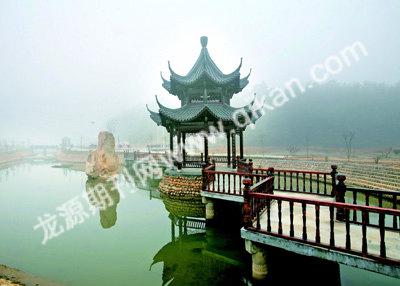Anji:a Pastoral Painting
2009-06-05TangChanghuanShiZhu
Tang Changhuan Shi Zhu

In March, 2009, Anji County started distributing 30-million-worth tourism coupons all over China, inviting tourists to see “Anji, a beautiful pastoral of China”. The coupons were first distributed among cities in the Yangtze River Delta and Hangzhou was the first to get the coupons.
Anji, a rural county in northern Zhejiang Province, is famed for its bamboo forests. On January 15, 2008, the countys peoples congress adopted a resolution to build itself into a county with “Chinas Beautiful Villages”.
Before the ambitious project was launched on a large-scale across the county, Anji was already recognized as the Home of Bamboo and a national ecological model. The latest project aims to reshape Anji into a rural prototype of China. What the county wants is the most beautiful rural vista, the cleanest village appearance, a rural economy that best fits with regional characteristics, most full-fledged public services, most flourishing regional culture, and a happiest rural life.
The project is to refurbish all of the countys 187 administrative villages. The whole county is to be redesigned as a tourism zone in the master plan, each village is to be remodeled as a tourism attraction and each house is to be rebuilt as a separate villa. The county has formulated an outline and a general implementation plan for the 10-year project to translate the dream into reality. The towns across the county have dreamed up their individual corresponding designs to improve environment, local economy, public service and rural lifestyle.
The cost for the project is estimated to be 12-14 billion yuan. How can the county with a yearly revenue of 1.5 billion afford such a large-scale project? The county government has set up a fund and put 200 million a year into the special coffer. The money will not be allocated as capital. It will be issued as grants and awards after micro-projects are completed. The financial support is a chain: the county government gives a certain amount of awards, the county government issues a certain amount of awards, villages chip in out of their own purses, enterprises contribute a part of needed capital, and investors from outside the county are encouraged to participate in individual village projects. Some money can be raised through markets. At present, 136 businesses in the county have teamed up with 125 administrative villages to kick off their separate projects. 370 million has been committed for 424 village programs by first batch of 61 “Chinas Beautiful Villages”.
The county conducted its first acceptance check at the end of 2008. Fifty villages were found up to standard.
Xie Shaoming, a farmer in the village of Shiling, was one of the first villagers that responded to the project. With a remodeling plan done by a professional designer, the house went under a facelift project. Without any major structural change, the house now looks completely different at the cost of less than 40,000 yuan. The villa-styled house merges perfectly with the environment.

Shanchuan Town, a rural area with 92% of its land covered by vegetation, has benefited from the county project. The town has cleaned up some untidy spots in areas between villages, installed household wastewater treatment projects into most villages, set up a network of refuse disposal that covers all the villages, and introduced a clean drinking water system into 90% of the households. Nowadays, investors come to choose projects formulated by the town planners. It is now way beyond the phase when the county grabbed all kinds of investments without asking too many questions.
Shiling Village is now a rural destination that offers a special entertainment. Twenty-eight households in the village run their family businesses as a one-stop dine and wine hospitality. Tourists come to unwind and enjoy rural diet. Nowadays, there are more than 500 household restaurants in picturesque villages across Anji which cater to urban visitors who come to enjoy a pastoral scenery of bamboo forests, bubbling streams and mountains. The village is now accessed by a five-km road lined with 2,000 crape myrtle.
For eight consecutive years, Anji has led the province in terms of per capita income in its rural area. The county is known for its highly specialized rural industries. Huangdu, home to eight prize-winning white-tea enterprises, is a village of 420 households. The per capita income of the village was 15,600 yuan last year. The villagers have more than 100 cars. Eight families in the village live with village subsidies, victimized by long-term diseases or disability. The rest of 412 households now live in their villa-styled villas. White tea is now a big business in Anji. The output value of the white tea for 2009 is estimated to be 675 million yuan.
Regional culture is another highlight of the new rural reconstruction project. Villages keep their distinct features and traditions. The village of Yutiao has hundreds of amateur painters and calligraphers. Some of them make a living by painting on paper-fans for a local business. Nowadays, the village has an institute where amateur artists gather. Guishanchang Village is going to build a museum to reproduce its ancient bamboo-rafting history. In good old days, the villagers transported bamboo rafts to the outside world.
Nowadays, Anji is included in a UN-network for habitats for sustainable cooperation and development. The inclusion means that the county government is the first in China that has qualified to apply for a UN-habitat award. □
